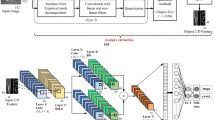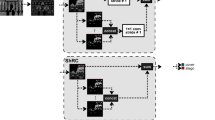Abstract
Recent studies have indicated that Convolutional Neural Network (CNN), incorporated with certain domain knowledge, is capable of achieving competitive performances on discriminating trivial perturbation introduced by spatial steganographic schemes. In this paper, we propose a deep residual multi-scale convolutional network model, which outperforms several CNN-based steganalysis schemes and hand-crafted rich models. Compared to CNN-based steganalyzers proposed in recent studies, our model has a deeper network structure and it is integrated with a series of proven elements and complicated convolutional modules. With the intention of abstracting features from various dimensions, multi-scale convolutional modules are designed in three different ways. Besides, inspired by the idea of residual learning, shortcut components are adopted in the proposed model. Extensive experiments with BOSSbase v1.01 and LIRMMBase are carried out, which demonstrates that our network is able to detect multiple state-of-the-art spatial embedding schemes with different payloads.
Access this chapter
Tax calculation will be finalised at checkout
Purchases are for personal use only
Similar content being viewed by others
References
Bas, Patrick, Filler, Tomáš, Pevný, Tomáš: “Break our steganographic system”: the ins and outs of organizing BOSS. In: Filler, Tomáš, Pevný, Tomáš, Craver, Scott, Ker, Andrew (eds.) IH 2011. LNCS, vol. 6958, pp. 59–70. Springer, Heidelberg (2011). https://doi.org/10.1007/978-3-642-24178-9_5
Bianchini, M., Scarselli, F.: On the complexity of neural network classifiers: a comparison between shallow and deep architectures. IEEE Trans. Neural Netw. Learn. Syst. 25(8), 1553–1565 (2014)
Denemark, T., Sedighi, V., Holub, V., Cogranne, R., Fridrich, J.: Selection-channel-aware rich model for steganalysis of digital images. In: Proceedings of the 2014 IEEE International Workshop on Information Forensics and Security, Atlanta, GA, USA, pp. 48–53 (2014)
Filler, T., Judas, J., Fridrich, J.: Minimizing additive distortion in steganography using syndrome-trellis codes. IEEE Trans. Inf. Forensics Secur. 6(3–2), 920–935 (2011)
Fridrich, J., Kodovský, J.: Rich models for steganalysis of digital images. IEEE Trans. Inf. Forensics Secur. 7(3), 868–882 (2012)
He, K., Zhang, X., Ren, S., Sun, J.: Deep residual learning for image recognition. In: Proceedings of the 2016 IEEE Conference on Computer Vision and Pattern Recognition, Las Vegas, NV, USA, pp. 770–778 (2016)
Holub, V., Fridrich, J.: Designing steganographic distortion using directional filters. In: Proceedings of the 2012 IEEE International Workshop on Information Forensics and Security, Costa Adeje, Tenerife, Spain, pp. 234–239 (2012)
Holub, V., Fridrich, J.: Random projections of residuals for digital image steganalysis. IEEE Trans. Inf. Forensics Secur. 8(12), 1996–2006 (2013)
Holub, V., Fridrich, J., Denemark, T.: Universal distortion function for steganography in an arbitrary domain. EURASIP J. Inf. Secur. 2014, 1 (2014)
Huang, G., Liu, Z., van der Maaten, L., Weinberger, K.Q.: Densely connected convolutional networks. In: Proceedings of the 2017 IEEE Conference on Computer Vision and Pattern Recognition, Honolulu, HI, USA, pp. 2261–2269 (2017)
Ioffe, S., Szegedy, C.: Batch normalization: accelerating deep network training by reducing internal covariate shift. In: Proceedings of the 32nd International Conference on Machine Learning, Lille, France, pp. 448–456 (2015)
Pevný, T., Filler, T., Bas, P.: Using high-dimensional image models to perform highly undetectable steganography. In: Proceedings of the 12th International Workshop on Information Hiding, Calgary, AB, Canada, pp. 161–177 (2010)
Pibre, L., Pasquet, J., Ienco, D., Chaumont, M.: Deep learning is a good steganalysis tool when embedding key is reused for different images, even if there is a cover sourcemismatch. In: Proceedings of the 2016 IS&T, Electronic Imaging, Media Watermarking, Security, and Forensics, San Francisco, CA, USA, pp. 1–11 (2016)
Qian, Y., Dong, J., Wang, W., Tan, T.: Deep learning for steganalysis via convolutional neural networks. In: Proceedings of the 2015 IS&T, Electronic Imaging, Media Watermarking, Security, and Forensics, San Francisco, CA, USA, p. 94090J (2015)
Qian, Y., Dong, J., Wang, W., Tan, T.: Learning and transferring representations for image steganalysis using convolutional neural network. In: Proceedings of the 2016 IEEE International Conference on Image Processing, Phoenix, AZ, USA, pp. 2752–2756 (2016)
Simonyan, K., Zisserman, A.: Very deep convolutional networks for large-scale image recognition. CoRR abs/1409.1556 (2014). http://arxiv.org/abs/1409.1556
Sun, S., Chen, W., Wang, L., Liu, X., Liu, T.: On the depth of deep neural networks: a theoretical view. In: Proceedings of the 30th AAAI Conference on Artificial Intelligence, Phoenix, AZ, USA, pp. 2066–2072 (2016)
Szegedy, C., Ioffe, S., Vanhoucke, V., Alemi, A.A.: Inception-v4, inception-resnet and the impact of residual connections on learning. In: Proceedings of the 31st AAAI Conference on Artificial Intelligence, San Francisco, CA, USA, pp. 4278–4284 (2017)
Szegedy, C., et al.: Going deeper with convolutions. In: Proceedings of the 2015 IEEE Conference on Computer Vision and Pattern Recognition, Boston, MA, USA, pp. 1–9 (2015)
Szegedy, C., Vanhoucke, V., Ioffe, S., Shlens, J., Wojna, Z.: Rethinking the inception architecture for computer vision. In: Proceedings of the 2016 IEEE Conference on Computer Vision and Pattern Recognition, Las Vegas, NV, USA, pp. 2818–2826 (2016)
Tan, S., Li, B.: Stacked convolutional auto-encoders for steganalysis of digital images. In: Proceedings of the 2014 Asia-Pacific Signal and Information Processing Association Annual Summit and Conference, Chiang Mai, Thailand, pp. 1–4 (2014)
Wu, S., Zhong, S., Liu, Y.: Steganalysis via deep residual network. In: Proceedings of the 22nd IEEE International Conference on Parallel and Distributed Systems, Wuhan, China, pp. 1233–1236 (2016)
Wu, S., Zhong, S., Liu, Y.: Residual convolution network based steganalysis with adaptive content suppression. In: Proceedings of the 2017 IEEE International Conference on Multimedia and Expo, Hong Kong, China, pp. 241–246 (2017)
Wu, S., Zhong, S., Liu, Y.: Deep residual learning for image steganalysis. Multimedia Tools Appl. 77(9), 10437–10453 (2018)
Xu, G.: Deep convolutional neural network to detect J-UNIWARD. In: Proceedings of the 5th ACM Workshop on Information Hiding and Multimedia Security, Philadelphia, PA, USA, pp. 67–73 (2017)
Xu, G., Wu, H., Shi, Y.Q.: Ensemble of CNNs for steganalysis: an empirical study. In: Proceedings of the 4th ACM Workshop on Information Hiding and Multimedia Security, Vigo, Galicia, Spain, pp. 103–107 (2016)
Xu, G., Wu, H., Shi, Y.: Structural design of convolutional neural networks for steganalysis. IEEE Signal Process. Lett. 23(5), 708–712 (2016)
Yang, J., Liu, K., Kang, X., Wong, E.K., Shi, Y.: Steganalysis based on awareness of selection-channel and deep learning. In: Proceedings of the 16th International Workshop on Digital Forensics and Watermarking, Magdeburg, Germany, pp. 263–272 (2017)
Ye, J., Ni, J., Yi, Y.: Deep learning hierarchical representations for image steganalysis. IEEE Trans. Inf. Forensics Secur. 12(11), 2545–2557 (2017)
Yedroudj, M., Chaumont, M., Comby, F.: How to augment a small learning set for improving the performances of a CNN-based steganalyzer? CoRR abs/1801.04076 (2018). http://arxiv.org/abs/1801.04076
Yedroudj, M., Comby, F., Chaumont, M.: Yedrouj-net: an efficient CNN for spatial steganalysis. CoRR abs/1803.00407 (2018). http://arxiv.org/abs/1803.00407
Yuan, Y., Lu, W., Feng, B., Weng, J.: Steganalysis with CNN using multi-channels filtered residuals. In: Proceedings of the 3rd International Conference on Cloud Computing and Security, Nanjing, China, pp. 110–120 (2017)
Zeiler, M.D.: ADADELTA: an adaptive learning rate method. CoRR abs/1212.5701 (2012). http://arxiv.org/abs/1212.5701
Zhu, X., Liu, J., Wang, J., Li, C., Lu, H.: Sparse representation for robust abnormality detection in crowded scenes. Pattern Recogn. 47(5), 1791–1799 (2014)
Acknowledgments
This work was supported by NSFC under 61802393, U1636102, U1736214 and 61872356, National Key Technology R&D Program under 2016YFB0801003 and 2016QY15Z2500, and Project of Beijing Municipal Science & Technology Commission under Z181100002718001.
Author information
Authors and Affiliations
Corresponding author
Editor information
Editors and Affiliations
Rights and permissions
Copyright information
© 2019 Springer Nature Switzerland AG
About this paper
Cite this paper
Zhang, S., Zhang, H., Zhao, X., Yu, H. (2019). A Deep Residual Multi-scale Convolutional Network for Spatial Steganalysis. In: Yoo, C., Shi, YQ., Kim, H., Piva, A., Kim, G. (eds) Digital Forensics and Watermarking. IWDW 2018. Lecture Notes in Computer Science(), vol 11378. Springer, Cham. https://doi.org/10.1007/978-3-030-11389-6_4
Download citation
DOI: https://doi.org/10.1007/978-3-030-11389-6_4
Published:
Publisher Name: Springer, Cham
Print ISBN: 978-3-030-11388-9
Online ISBN: 978-3-030-11389-6
eBook Packages: Computer ScienceComputer Science (R0)




